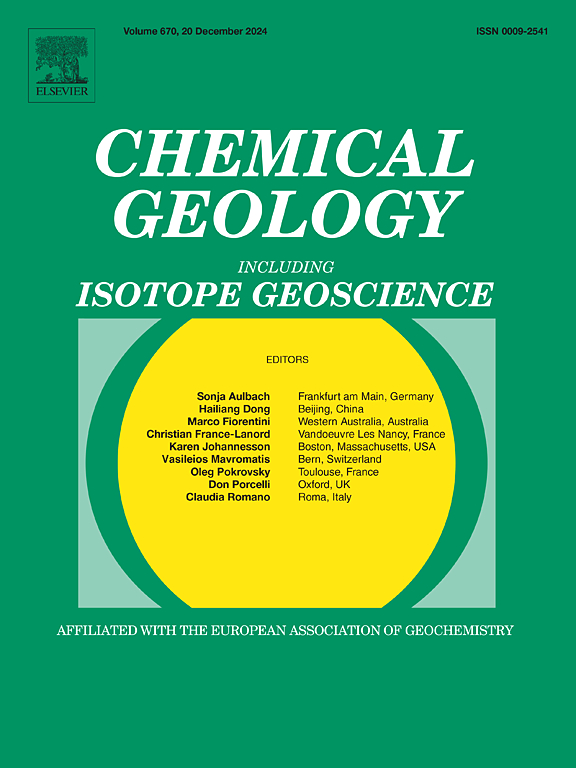Validating the rhenium proxy for rock organic carbon oxidation using weathering profiles
IF 3.6
2区 地球科学
Q1 GEOCHEMISTRY & GEOPHYSICS
引用次数: 0
Abstract
Chemical weathering over geological timescales acts as a source or sink of atmospheric carbon dioxide (CO2), while influencing long-term redox cycling and atmospheric oxygen (O2) at Earth's surface. There is a growing recognition that the oxidative weathering of rock organic carbon (OCpetro) can release more CO2 than is locally drawn down by silicate weathering, and may vary due to changes in erosion and climate. The element rhenium (Re) has emerged as a proxy to track the oxidative weathering of OCpetro, yet uncertainties in its application remain namely that we lack a systematic assessment of the comparative mobility of Re and OCpetro during sedimentary rock weathering. Here we measure Re and OCpetro loss across gradients in rock weathering at 9 global sites, spanning a range of initial OCpetro values from ∼0.2 % to >10 %. We use titanium to account for volume changes during weathering and assess Re and OCpetro loss alongside major elements that reflect silicate (Na, Mg), carbonate (Ca, Mg) and sulfide (S) weathering. Across the dataset, Re loss is correlated with OCpetro loss but not with loss of any other major element. Across the weathering profiles, the average molar ratio of OCpetro to Re loss was 0.84 ± 0.15, with 8 out of 9 sites having a ratio >0.74. At one site (Marcellus Shale), the average ratio was lower at 0.58 ± 0.11. The excess loss of Re matches expectations that, typically, between ∼0 and 20 % of the Re liberated by sedimentary rock weathering derives from silicate or sulfide phases, while some OCpetro may be physically or chemically protected from weathering. Overall, our measurements provide validation for the Re proxy of OCpetro oxidation and allow future work to further improve our knowledge of regional and global-scale rates of this important source of CO2 in the geochemical carbon cycle.
利用风化剖面验证岩石有机碳氧化的铼替代物
在地质时间尺度上,化学风化作用是大气中二氧化碳(CO2)的源或汇,同时影响着地球表面的长期氧化还原循环和大气中的氧(O2)。越来越多的人认识到,岩石有机碳(OCpetro)的氧化风化作用释放的二氧化碳可能比硅酸盐风化作用在当地汲取的二氧化碳还要多,而且可能因侵蚀和气候的变化而变化。铼(Re)元素已成为跟踪岩石有机碳氧化风化的替代物,但其应用仍存在不确定性,即我们缺乏对沉积岩风化过程中铼和岩石有机碳流动性比较的系统评估。在这里,我们测量了全球 9 个地点岩石风化过程中的芮氏和氧化还原剂的梯度损失,这些地点的氧化还原剂初始值范围从 0.2% 到 10%。我们使用钛来解释风化过程中的体积变化,并评估 Re 和 OCpetro 损失以及反映硅酸盐(Na、Mg)、碳酸盐(Ca、Mg)和硫化物(S)风化的主要元素。在整个数据集中,Re 的损失与 OCpetro 的损失相关,但与任何其他主要元素的损失无关。在整个风化剖面中,OCpetro 与 Re 损失的平均摩尔比为 0.84 ± 0.15,9 个地点中有 8 个地点的比值为 0.74。在一个地点(马塞勒斯页岩),平均比率较低,为 0.58 ± 0.11。Re的过量损失符合人们的预期,即沉积岩风化释放的Re通常有0%到20%来自硅酸盐或硫化物相,而一些OCpetro可能受到物理或化学保护而不被风化。总之,我们的测量结果验证了OCpetro氧化的Re替代物,并使未来的工作能够进一步提高我们对地球化学碳循环中这一重要CO2源的区域和全球尺度速率的认识。
本文章由计算机程序翻译,如有差异,请以英文原文为准。
求助全文
约1分钟内获得全文
求助全文
来源期刊

Chemical Geology
地学-地球化学与地球物理
CiteScore
7.20
自引率
10.30%
发文量
374
审稿时长
3.6 months
期刊介绍:
Chemical Geology is an international journal that publishes original research papers on isotopic and elemental geochemistry, geochronology and cosmochemistry.
The Journal focuses on chemical processes in igneous, metamorphic, and sedimentary petrology, low- and high-temperature aqueous solutions, biogeochemistry, the environment and cosmochemistry.
Papers that are field, experimentally, or computationally based are appropriate if they are of broad international interest. The Journal generally does not publish papers that are primarily of regional or local interest, or which are primarily focused on remediation and applied geochemistry.
The Journal also welcomes innovative papers dealing with significant analytical advances that are of wide interest in the community and extend significantly beyond the scope of what would be included in the methods section of a standard research paper.
 求助内容:
求助内容: 应助结果提醒方式:
应助结果提醒方式:


